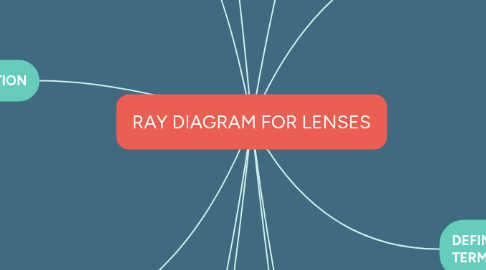RAY DIAGRAM FOR LENSES
Aira Linabanにより


1. TYPES OF LENSES
1.1. Converging lenses causes parallel light rays to come together (i.e. converge) toward a common point.
1.2. Diverging lenses cause parallel rays of light to spread away from a common point (i.e. diverge).
2. INTRODUCTION
2.1. Different types of lenses play an important part in our lives. They are used in cameras, telescopes, microscopes, and projectors. The also enable millions of people to read comfortably and to see clearly.
2.2. Lenses have two sides, and either side can be plane, concave, or convex (i.e. can have two different types of sides). There are many types of lenses, but the ones that we will become familiar with are diverging and converging lenses.
3. EXAMPLE OF CONVERGING LENSES
3.1. Magnifying Glasses-Move the glass farther from the object and it will become distorted; move the glass closer to the object and it will decrease in magnification.
3.2. Eyeglasses-A converging lens placed in front of the eye bends the incoming light sharply so the focal point shortens and the light focuses properly on the retina.In the case of farsightedness, the lens of the eye focuses the image too far behind the retina. This causes difficulty in focusing on objects close to the eye.
3.3. Cameras -utilize converging lenses not only to focus an image but also to magnify it.
4. RULES FOR DIVERGING LENSES:
4.1. Any incident ray traveling parallel to the principal axis of a diverging lens will refract through the lens and travel in line with the focal point (i.e., in a direction such that its extension will pass through the focal point).
4.2. Any incident ray traveling towards the focal point on the way to the lens will refract through the lens and travel parallel to the principal axis.
4.3. An incident ray that passes through the center of the lens will in effect continue in the same direction that it had when it entered the lens.
5. RAY DIAGRAM FOR CONVERGING LENSES
5.1. THE OBJECT IS LOCATED BEYOND 2F
5.1.1. L-BETWEEN F AND 2F,O-INVERTED,S-REDUCED,T-REAL IMAGE
5.2. THE OBJECT IS LOCATED AT 2F
5.2.1. L-AT 2F,O-INVERTED,S-EQUAL,T-REAL IMAGE
5.3. THE OBJECT IS LOCATED BETWEEN 2F AND F
5.3.1. L-BEYOND 2F,O-INVERTED,S-ENLARGED,T-REAL IMAGE
5.4. THE OBJECT IS LOCATED AT F
5.4.1. NO IMAGE FORM
5.5. THE OBJECT IS LOCATED IN FRONT OF F
5.5.1. L-BEHIND THE OBJECT,O-UPRIGHT,S-ENLARGED,T-VIRTUAL IMAGE

